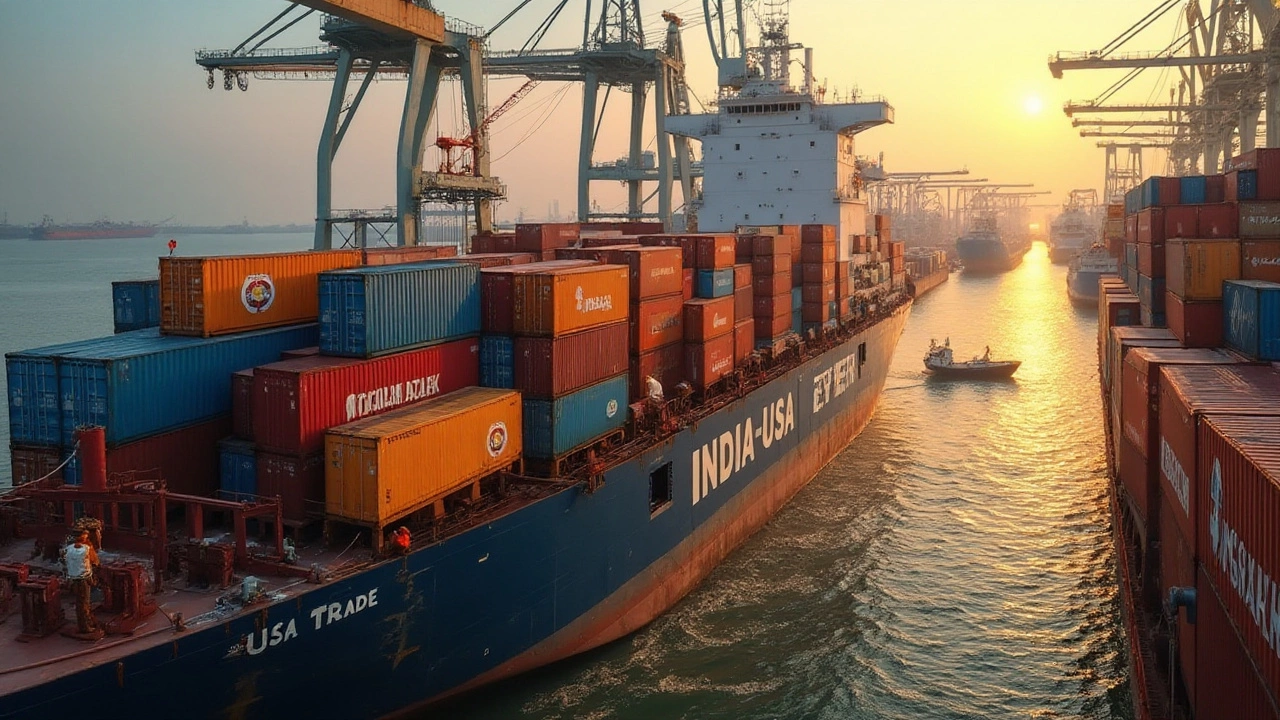Breaking into the American market can be an enticing prospect for Indian business owners. With its vast consumer base and diverse tastes, the USA offers a wealth of opportunities for those looking to expand their reach beyond Indian shores.
The journey, however, is dotted with its unique set of challenges, making it crucial to understand the intricacies involved in exporting goods from India to the states. From gauging the ever-evolving market needs, to ensuring your products meet regulatory requirements, each step demands meticulous planning and execution.
This guide aims to provide practical insights and strategies to navigate through this complex but rewarding process, equipping you with the knowledge to succeed in the realm of international trade.
- Understanding Market Needs
- Navigating Regulatory Requirements
- Logistics and Documentation
- Tips from Experienced Exporters
Understanding Market Needs
Embarking on the journey of exporting goods from India to the USA begins with an in-depth understanding of the American market landscape. This isn't merely about knowing what products are trending; it requires a robust comprehension of consumer behavior, preferences, and purchasing power across different states. The USA is vast, with varied tastes influenced by cultural diversity, socioeconomic factors, and regional norms. By identifying these nuances, exporters can tailor their offerings to meet specific demand, ensuring that their goods resonate with the target audience.
Research is pivotal in this phase. Leveraging both primary and secondary data sources can shed light on potential gaps where Indian exports might thrive. Surveys, focus groups, and interviews with consumers offer direct insights, while government trade reports, industry publications, and market analyses provide a macro view. According to the United States Trade Representative, trade between India and the USA has been growing steadily, hitting billions annually. This data underscores the potential impact and value of well-aligned market strategies for Indian exporters.
"Successful exporters aren't those who just respond to trends, but those who anticipate and shape them," notes Anil Gupta, one of India's leading economists. This forward-thinking approach requires an exporter to delve into technological advancements, emerging industries, and shifting consumer preferences.In recent years, there's been an increased appetite for sustainable and ethically produced goods amongst American consumers. The 'conscious consumerism' wave presents a unique opportunity for Indian exporters who can authentically deliver on those values, making it imperative to highlight product origins, sustainable practices, and fair trade certifications.
Tools and Techniques
Analyzing competitors that have found success in the American market can also offer valuable lessons. Observing market leaders can unveil what works and what doesn’t in your sector. An effective way to facilitate this analysis is through a SWOT analysis, helping you map strengths, weaknesses, opportunities, and threats in a structured manner. Utilizing platforms like Google Trends and consumer feedback tools can also provide ongoing insights into changing needs and preferences. This dynamic approach keeps Indian exporters adept at pivoting strategies to sustain relevance in the ever-evolving U.S. market.
Navigating Regulatory Requirements
When venturing into exporting goods from India to the USA, understanding the regulatory landscape is paramount. As an exporter, you need to familiarize yourself with both country's regulations to avoid costly pitfalls. The USA, known for its regimented import protocols, mandates that all imported goods comply with the standards set by various federal agencies, such as the Food and Drug Administration (FDA) and the U.S. Customs and Border Protection (CBP). Compliance isn't just about ticking boxes; it's about ensuring your products meet health, safety, and environmental standards that protect American consumers. These requirements can vary significantly depending on the type of product you aim to export. For instance, food products must pass through stringent FDA evaluations, ensuring they are free from contaminants and properly labeled according to U.S. guidelines.
The documentation process can be daunting without prior knowledge. Some key documents include the commercial invoice, packing list, bill of lading, and the certificate of origin. Each plays a crucial role in the importation process. The commercial invoice is pivotal as it provides details regarding the transaction between the buyer and seller. It’s essentially a bill that specifies the goods being sent, their quantity, and the agreements made. Meanwhile, the packing list details how goods are packed, which aids customs officials in identifying the contents. It’s also important to note the requirement for an Importer Security Filing (ISF), obligatory for ocean freight imported to the USA. This filing needs to be submitted 24 hours before the cargo is loaded at the origin sea port. Failing to meet this requirement can result in hefty fines.
Taxation and duties are other aspects that require your attention. The Harmonized Tariff System (HTS) helps categorize goods for accurate duty assessment. The US International Trade Commission’s website provides a comprehensive HTS database, allowing exporters to search for the code that applies to their products. This code determines the import tariffs that your goods will incur upon entry into the USA. Seasoned exporters understand the importance of taking advantage of free trade agreements (FTAs) between India and the USA, which can significantly reduce or eliminate duties. Notably, the Generalized System of Preferences (GSP) is a program that aids developing countries by allowing duty-free entry for up to 5,000 products from India.
"Navigating through the regulatory maze isn't just about compliance; it's about staying competitive and ensuring success," says trade specialist Anil Kapoor.
As digitalization permeates every facet of international trade, adopting technology can simplify adherence to these regulations. Many exporters have integrated online platforms that automate compliance checks, ensuring that documentation aligns with U.S. regulatory frameworks. This not only reduces the margin for error but also accelerates the export process. Moreover, staying informed about regulatory changes is crucial, as these are often subject to amendments reflecting shifting economic and political landscapes. Regular consultation with trade specialists and attending industry seminars can keep you updated. The Export-Import Bank of India frequently organizes informative sessions and workshops that offer exporters valuable insights and networking opportunities.

Logistics and Documentation
Embarking on the journey of exporting goods from India to the USA requires a robust understanding of logistics and documentation. It’s a path often dotted with a fair share of complexities, warranting precise attention to detail. Effective logistics management can be the difference between a seamless export operation and one mired in inefficiencies. The logistics framework involves the coordination of a myriad of activities, from packaging and transportation to warehousing and timely delivery. Mindful of possible disruptions, businesses often develop contingency plans to ensure smoother processes. Partnering with reliable logistics providers who specialize in international shipping is key to handling unforeseen challenges efficiently, and having a team that can adeptly manage these operations is equally crucial.
The sort of documentation required for exporting goods largely hinges on the type of product, its value, and the regulatory demands of both India and the USA. Key documents commonly required include the commercial invoice, packing list, bill of lading or airway bill, and insurance certificate. A commercial invoice serves not only as a payment request but also documents the transaction and calculates customs duties applicable. Meanwhile, the bill of lading acts as a shipment receipt and evidence of the contract between the shipper and the carrier. The complexity of these documents often necessitates the expertise of a skilled customs broker who can navigate both the red tape and logistical potential pitfalls.
It is essential to ensure that the exported products comply with the export controls of India and the import regulations of the USA. A failure to adhere to these can result in fines and, in some cases, forfeiture of the goods themselves. The Harmonized System (HS) code classification of products directly impacts duties and taxes, and attaining the correct codes is pivotal to ensuring compliance. Staying informed on trade agreements between India and the USA, such as the Generalized System of Preferences (GSP), can further benefit Indian exporters by reducing tariff rates on eligible products. Incorporating a robust tracking system to follow shipments provides real-time updates, enhancing accountability and customer satisfaction.
Common Hurdles and Expert Advice
While the potential rewards are significant, exporters should brace for common obstacles such as unpredictable customs clearance delays and the fluctuating costs of international shipping. Effective communication with buyers about possible delays can manage expectations and maintain a positive relationship. Engaging with industry experts and tapping into networks of experienced exporters can provide invaluable insights. As aptly captured by Anita Ramchandani, an export consultant, who states,
“An exporter must always prepare for the unexpected yet stay anchored in due diligence and compliance.”The blend of preparedness, consistent learning, and partnering with knowledgeable stakeholders ultimately delineates the successful exporter from the rest.
An overview of requirements as outlined by various logistics agencies reveals the multifaceted nature of this process:
| Document Type | Purpose | Source |
|---|---|---|
| Commercial Invoice | Transaction Details and Invoice | Exporter |
| Bill of Lading | Shipment Receipt | Shipping Carrier |
| Packing List | Helps with customs clearance | Exporter |
By integrating these elements into a comprehensive logistics and documentation strategy, exporters can efficiently navigate the export process, ensuring their businesses thrive on international shores.

Tips from Experienced Exporters
Standing on the shoulders of those who've trodden the path before can offer invaluable perspectives on succeeding in the often tumultuous landscape of international trade. Many seasoned exporters emphasize the importance of building strong relationships, not just with business partners in the USA, but also with freight forwarders, customs brokers, and regulatory bodies. A well-established network can often mean the difference between a smooth transaction and a logistical nightmare, and it can open doors to unexpected opportunities. Leveraging export business India networks for insights or introductions can significantly ease your entry into the American market.
Another critical tip is to stay on top of market trends. The tastes and preferences of American consumers can shift rapidly, as can the economic conditions influencing buying power. By continuously monitoring industry reports and economic indicators, exporters can adjust their strategies to stay ahead. Adapting quickly to market demands ensures that your products remain relevant and desirable. This flexibility is especially true for businesses focusing on goods such as textiles or technology, where trends can determine success.
An often-cited pièce of advice from seasoned voices is to get the paperwork right from the get-go. The bureaucratic red tape can be daunting, but approaching it with the diligence it requires can save headaches down the line. An understanding of the exporting goods process and meticulous documentation can prevent costly delays. Collaborating with legal experts familiar with regulations can also be a game-changer. As the adage goes, ‘measure twice, cut once’—this mindset can save both time and resources.
"Succeeding in international export is not just about moving goods but building bridges," says Anita Desai, a veteran exporter with over three decades of experience in the textile industry, "fostering trust and reliability echoes through all your transactions."
A commitment to quality cannot be understated. While the price point of goods is vital, American consumers have a discerning eye for quality and brands with a commitment to excellence often find more success. Striving for higher standards, obtaining certifications, and ensuring consistency can boost your reputation significantly. Being well-regarded for quality builds trust and often leads to repeat business, an essential factor in sustaining long-term success.
Lastly, consider utilizing digital marketing as part of your strategy. In today's interconnected world, having an online presence can vastly enhance visibility. Platforms like LinkedIn, Facebook, or trade-specific forums can be fertile ground for promoting your India to USA export business. Engaging content, focusing on the unique aspects of your goods, and interacting meaningfully with potential clients can draw attention to your offerings, helping you carve a niche in a competitive market.

